Abstract
Sequential immunoprecipitates show that H-2dm1 mutant cells express a hybrid "H-2D/L" antigen exhibiting determinants normally associated with two different gene products of the parental d haplotype-i.e., the H-2Dd and H-2Ld antigens. The hybrid H-2D/Ldm1 antigen appears to consist of a portion of the NH2-terminal extracellular half of the H-2Dd antigen "fused" to a portion of the COOH-terminal extracellular half of the H-2Ld antigen. This structure is inferred from the reactivity of dm1 antigens with cytotoxic T lymphocytes specific for H-2Ld determinants and with monoclonal antibodies specific for determinants in the structural domains of H-2Ld or H-2Dd. The H-2D/Ldm1 molecule apparently retains all of the third external domain (C2 or alpha 3) and part of the second external domain (C1 or alpha 2) of H-2Ld, but its first external domain (N or alpha 1) derives from H-2Dd. From these findings and from previous peptide mapping studies, we propose that the H-2D/Ldm1 antigen is the product of a hybrid gene that has resulted from an unequal crossover between the parental H-2Dd and H-2Ld genes, leaving the N exon and part of the C1 exon of the H-2Dd gene joined to the H-2Ld gene beginning somewhere within its C1 exon.
Full text
PDF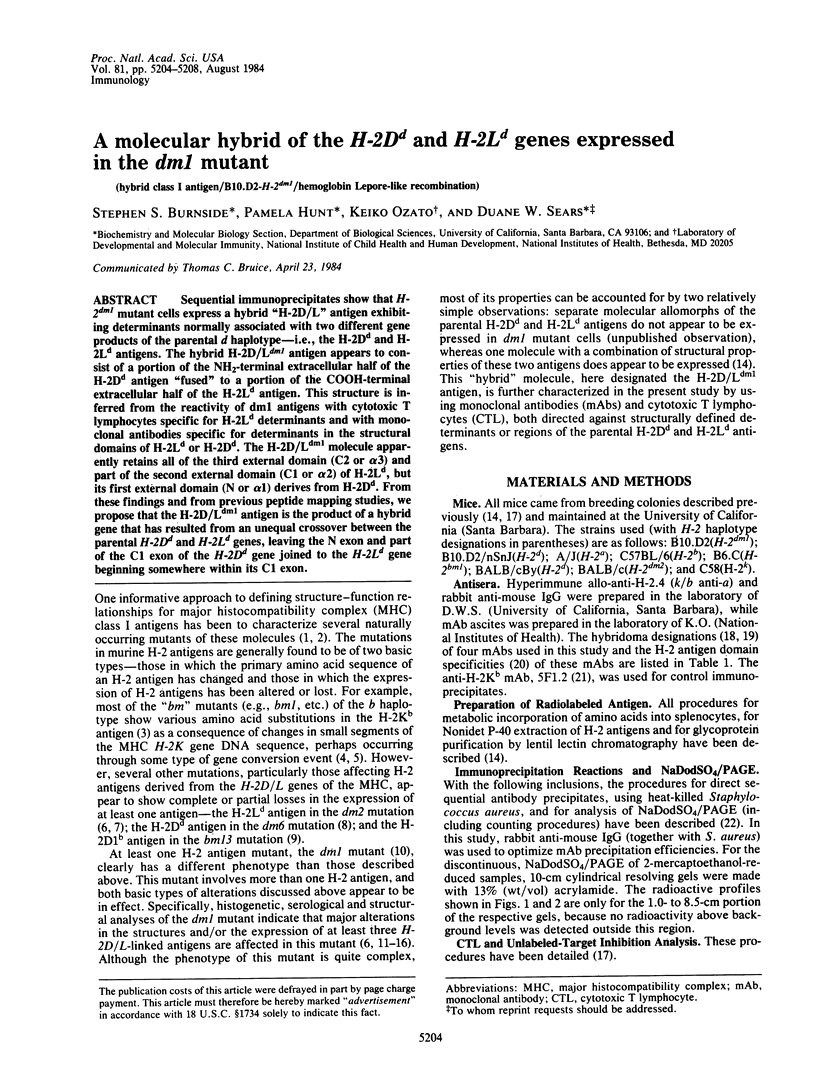
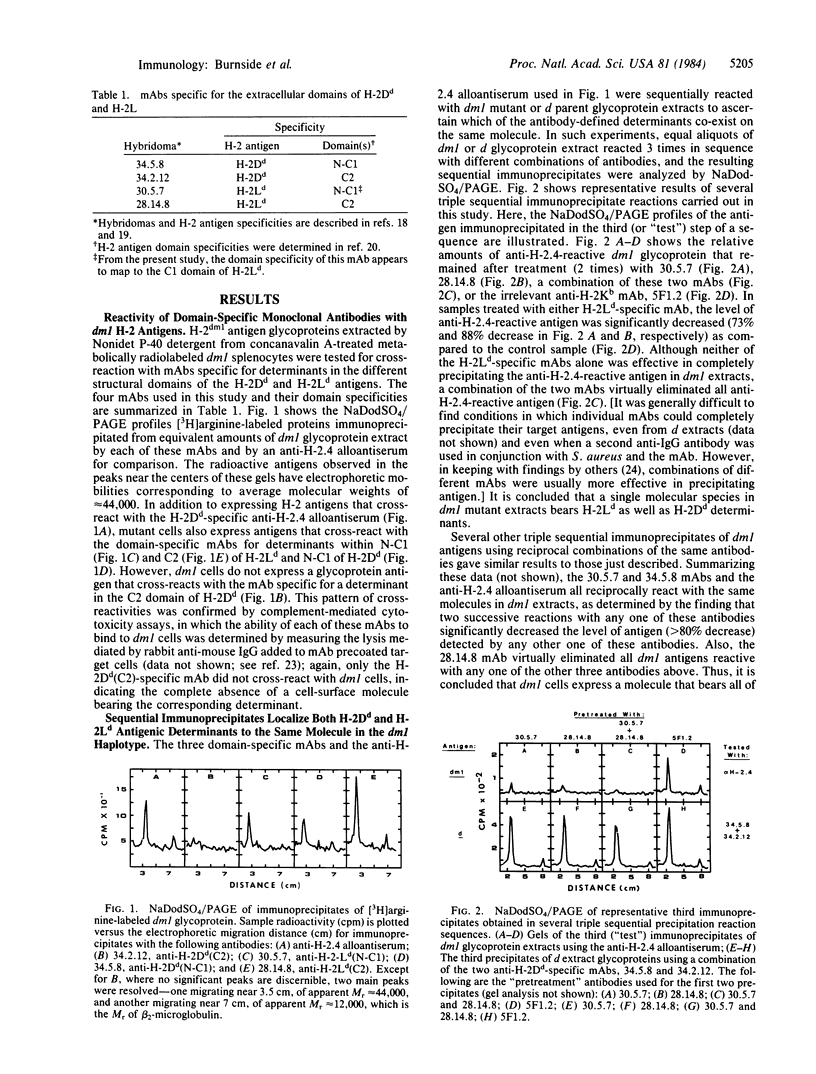
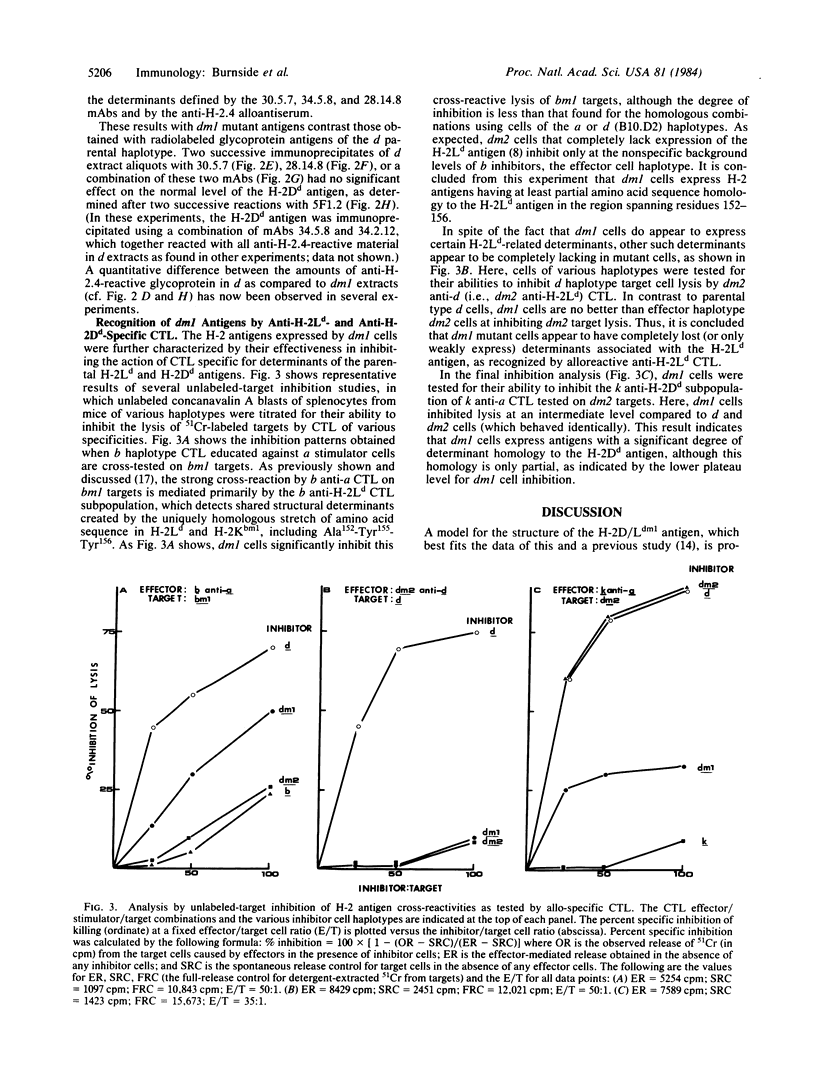
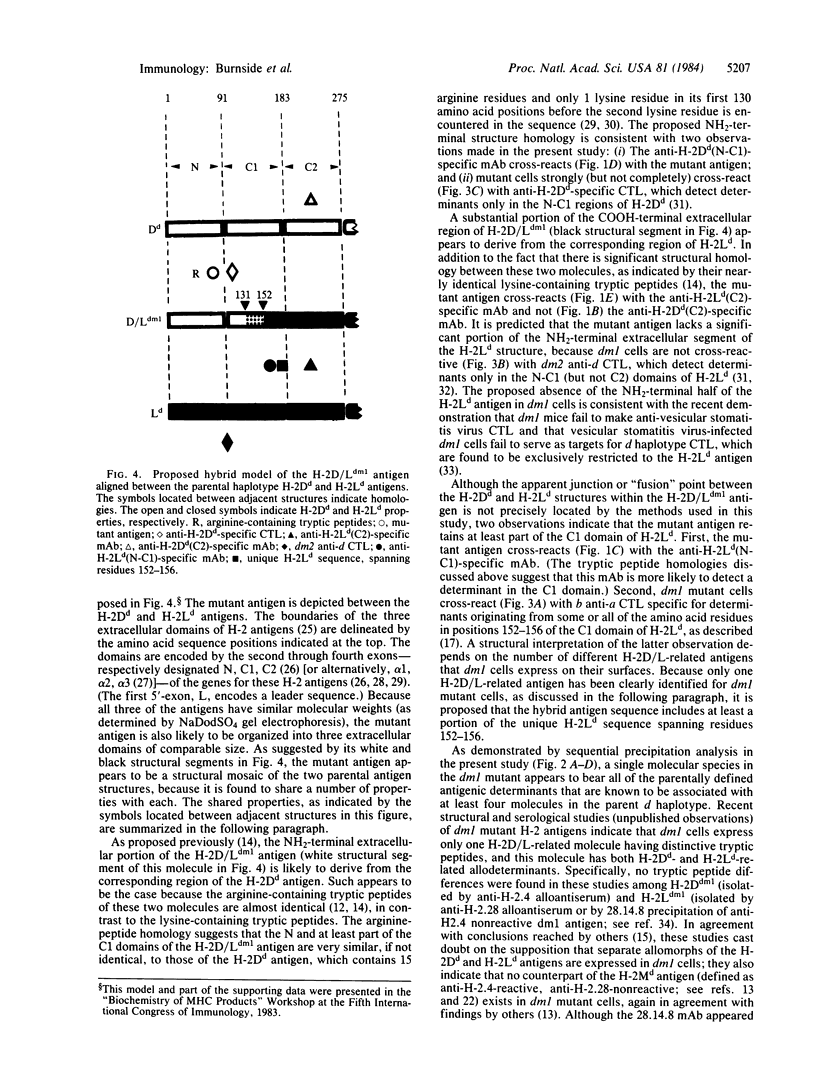
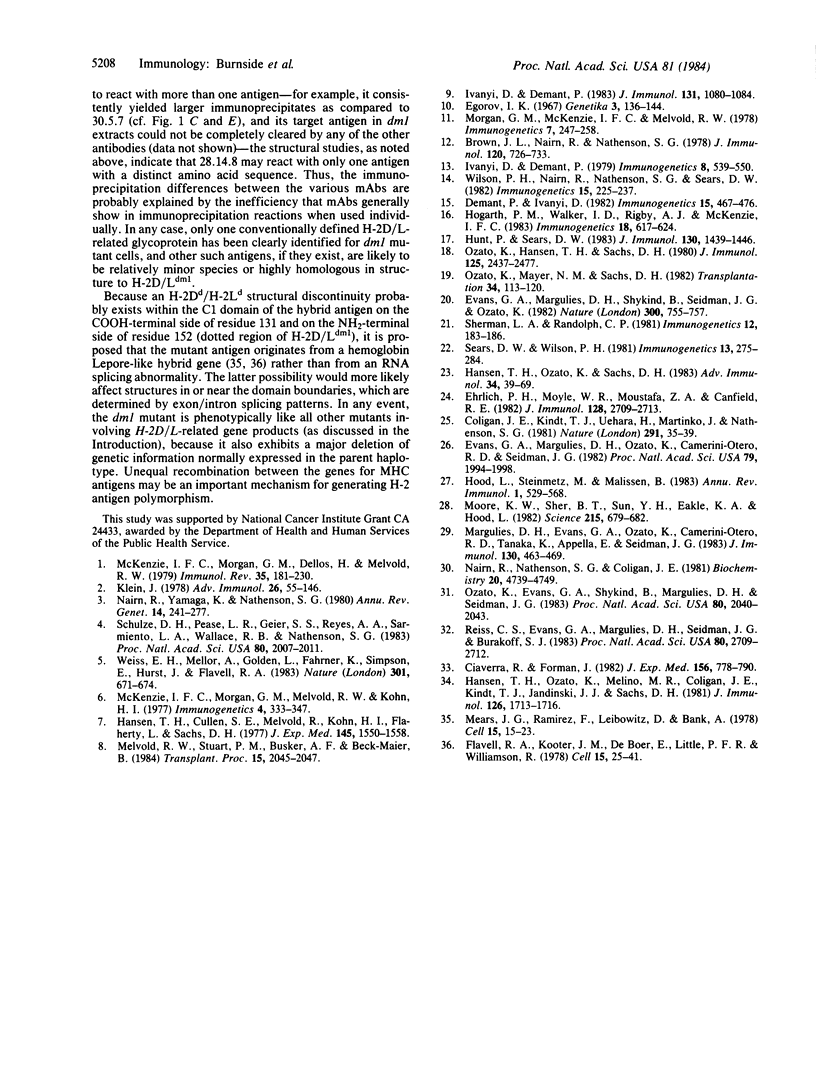
Selected References
These references are in PubMed. This may not be the complete list of references from this article.
- Brown J. L., Nairen R., Natherson S. G. Structural differences between the mouse H-2D products of the mutant B10.D2.M504 (H-2da) and the parental nonmutant strain B10.D2 (H-2d). J Immunol. 1978 Mar;120(3):726–733. [PubMed] [Google Scholar]
- Ciavarra R., Forman J. H-2L-restricted recognition of viral antigens In the H-2d haplotype, anti-vesicular stomatitis virus cytotoxic T cells are restricted solely by H-2L. J Exp Med. 1982 Sep 1;156(3):778–790. doi: 10.1084/jem.156.3.778. [DOI] [PMC free article] [PubMed] [Google Scholar]
- Coligan J. E., Kindt T. J., Uehara H., Martinko J., Nathenson S. G. Primary structure of a murine transplantation antigen. Nature. 1981 May 7;291(5810):35–39. doi: 10.1038/291035a0. [DOI] [PubMed] [Google Scholar]
- Ehrlich P. H., Moyle W. R., Moustafa Z. A., Canfield R. E. Mixing two monoclonal antibodies yields enhanced affinity for antigen. J Immunol. 1982 Jun;128(6):2709–2713. [PubMed] [Google Scholar]
- Evans G. A., Margulies D. H., Camerini-Otero R. D., Ozato K., Seidman J. G. Structure and expression of a mouse major histocompatibility antigen gene, H-2Ld. Proc Natl Acad Sci U S A. 1982 Mar;79(6):1994–1998. doi: 10.1073/pnas.79.6.1994. [DOI] [PMC free article] [PubMed] [Google Scholar]
- Evans G. A., Margulies D. H., Shykind B., Seidman J. G., Ozato K. Exon shuffling: mapping polymorphic determinants on hybrid mouse transplantation antigens. Nature. 1982 Dec 23;300(5894):755–757. doi: 10.1038/300755a0. [DOI] [PubMed] [Google Scholar]
- Flavell R. A., Kooter J. M., De Boer E., Little P. F., Williamson R. Analysis of the beta-delta-globin gene loci in normal and Hb Lepore DNA: direct determination of gene linkage and intergene distance. Cell. 1978 Sep;15(1):25–41. doi: 10.1016/0092-8674(78)90080-6. [DOI] [PubMed] [Google Scholar]
- Hansen T. H., Cullen S. E., Melvold R., Kohn H., Flaherty L., Sachs D. H. Mutation in a new H-2-associated histocompatibility gene closely linked to H-2D. J Exp Med. 1977 Jun 1;145(6):1550–1558. doi: 10.1084/jem.145.6.1550. [DOI] [PMC free article] [PubMed] [Google Scholar]
- Hansen T. H., Ozato K., Melino M. R., Coligan J. E., Kindt T. J., Jandinski J. J., Sachs D. H. Immunochemical evidence in two haplotypes for at least three D region-encoded molecules, D, L, and R. J Immunol. 1981 May;126(5):1713–1716. [PubMed] [Google Scholar]
- Hansen T. H., Ozato K., Sachs D. H. Heterogeneity of H-2D region associated genes and gene products. Adv Immunol. 1983;34:39–70. doi: 10.1016/s0065-2776(08)60376-4. [DOI] [PubMed] [Google Scholar]
- Hogarth P. M., Walker I. D., Rigby A. J., McKenzie I. F. The H-2dm1 mutation and Qa antigens. Immunogenetics. 1983;18(6):617–624. doi: 10.1007/BF00345969. [DOI] [PubMed] [Google Scholar]
- Hood L., Steinmetz M., Malissen B. Genes of the major histocompatibility complex of the mouse. Annu Rev Immunol. 1983;1:529–568. doi: 10.1146/annurev.iy.01.040183.002525. [DOI] [PubMed] [Google Scholar]
- Hunt P., Sears D. W. CTL cross-reactivities reveal shared immunodominant determinants created by structurally homologous regions of MHC class I antigens. J Immunol. 1983 Mar;130(3):1439–1446. [PubMed] [Google Scholar]
- Iványi D., Démant P. Molecular heterogeneity of D-end products detected by anti-H-2.28 sera. II. B10.D2(M504) (H-2dm1) mutant fails to express one of the two H-2.4-, 28 + Dd region molecules. Immunogenetics. 1982;15(5):467–476. doi: 10.1007/BF00345906. [DOI] [PubMed] [Google Scholar]
- Iványi D., Démant P. One (H-2D2b) of the three Db region-controlled molecules (H-2D1b, H-2D2b, H-2Lb) is not detected in bm13 mutant. J Immunol. 1983 Sep;131(3):1080–1084. [PubMed] [Google Scholar]
- Klein J. H-2 mutations: their genetics and effect on immune functions. Adv Immunol. 1978;26:55–146. doi: 10.1016/s0065-2776(08)60229-1. [DOI] [PubMed] [Google Scholar]
- Margulies D. H., Evans G. A., Ozato K., Camerini-Otero R. D., Tanaka K., Appella E., Seidman J. G. Expression of H-2Dd and H-2Ld mouse major histocompatibility antigen genes in L cells after DNA-mediated gene transfer. J Immunol. 1983 Jan;130(1):463–470. [PubMed] [Google Scholar]
- Mears J. G., Ramirez F., Leibowitz D., Bank A. Organization of human delta--and beta-globin genes in cellular DNA and the presence of intragenic inserts. Cell. 1978 Sep;15(1):15–23. doi: 10.1016/0092-8674(78)90079-x. [DOI] [PubMed] [Google Scholar]
- Melvold R. W., Stuart P. M., Busker A. E., Beck-Maier B. A new loss mutant in the H-2d haplotype. Transplant Proc. 1983 Dec;15(4):2045–2047. [PubMed] [Google Scholar]
- Moore K. W., Sher B. T., Sun Y. H., Eakle K. A., Hood L. DNA sequence of a gene encoding a BALB/c mouse Ld transplantation antigen. Science. 1982 Feb 5;215(4533):679–682. doi: 10.1126/science.7058332. [DOI] [PubMed] [Google Scholar]
- Nairn R., Nathenson S. G., Coligan J. E. Amino acid sequence of cyanogen bromide fragment CN-C (residues 24-98) of the mouse histocompatibility antigen H-2Dd. A comparison of the amino-terminal 100 residues of H-2Dd, Dd, Kd, and Kb reveals discrete areas of diversity. Biochemistry. 1981 Aug 4;20(16):4739–4745. doi: 10.1021/bi00519a033. [DOI] [PubMed] [Google Scholar]
- Nairn R., Yamaga K., Nathenson S. G. Biochemistry of the gene products from murine MHC mutants. Annu Rev Genet. 1980;14:241–277. doi: 10.1146/annurev.ge.14.120180.001325. [DOI] [PubMed] [Google Scholar]
- Ozato K., Evans G. A., Shykind B., Margulies D. H., Seidman J. G. Hybrid H-2 histocompatibility gene products assign domains recognized by alloreactive T cells. Proc Natl Acad Sci U S A. 1983 Apr;80(7):2040–2043. doi: 10.1073/pnas.80.7.2040. [DOI] [PMC free article] [PubMed] [Google Scholar]
- Ozato K., Hansen T. H., Sachs D. H. Monoclonal antibodies to mouse MHC antigens. II. Antibodies to the H-2Ld antigen, the products of a third polymorphic locus of the mouse major histocompatibility complex. J Immunol. 1980 Dec;125(6):2473–2477. [PubMed] [Google Scholar]
- Ozato K., Mayer N. M., Sachs D. H. Monoclonal antibodies to mouse major histocompatibility complex antigens. Transplantation. 1982 Sep;34(3):113–120. doi: 10.1097/00007890-198209000-00001. [DOI] [PubMed] [Google Scholar]
- Reiss C. S., Evans G. A., Margulies D. H., Seidman J. G., Burakoff S. J. Allospecific and virus-specific cytolytic T lymphocytes are restricted to the N or C1 domain of H-2 antigens expressed on L cells after DNA-mediated gene transfer. Proc Natl Acad Sci U S A. 1983 May;80(9):2709–2712. doi: 10.1073/pnas.80.9.2709. [DOI] [PMC free article] [PubMed] [Google Scholar]
- Schulze D. H., Pease L. R., Geier S. S., Reyes A. A., Sarmiento L. A., Wallace R. B., Nathenson S. G. Comparison of the cloned H-2Kbm1 variant gene with the H-2Kb gene shows a cluster of seven nucleotide differences. Proc Natl Acad Sci U S A. 1983 Apr;80(7):2007–2011. doi: 10.1073/pnas.80.7.2007. [DOI] [PMC free article] [PubMed] [Google Scholar]
- Sears D. W., Wilson P. H. Biochemical evidence for structurally distinct H-2Dd antigens differing in serological properties. Immunogenetics. 1981;13(4):275–284. doi: 10.1007/BF00364493. [DOI] [PubMed] [Google Scholar]
- Sherman L. A., Randolph C. P. Monoclonal anti-H-2Kb antibodies detect serological differences between H-2Kb mutants. Immunogenetics. 1981;12(1-2):183–186. doi: 10.1007/BF01561661. [DOI] [PubMed] [Google Scholar]
- Weiss E. H., Mellor A., Golden L., Fahrner K., Simpson E., Hurst J., Flavell R. A. The structure of a mutant H-2 gene suggests that the generation of polymorphism in H-2 genes may occur by gene conversion-like events. Nature. 1983 Feb 24;301(5902):671–674. doi: 10.1038/301671a0. [DOI] [PubMed] [Google Scholar]
- Wilson P. H., Nairn R., Nathenson S. G., Sears D. W. Unexpected complexity of the dm1 mutation revealed in the structure of three H-2D/L-related antigens. Immunogenetics. 1982 Mar;15(3):225–237. doi: 10.1007/BF00364331. [DOI] [PubMed] [Google Scholar]


